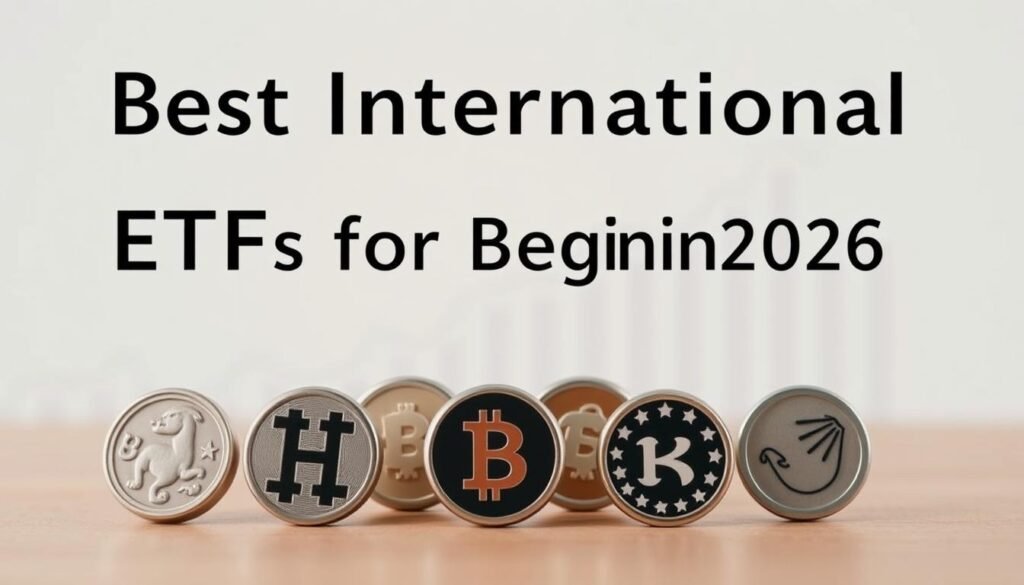
Best International ETFs for Beginners 2026

This short guide opens with a quick, friendly story so you know what to expect.
Imagine you bought a single stock years ago and watched it soar while other parts of your savings lagged. That real sting nudged one mid‑level investor to learn about adding broad global exposure.
You’ll get a simple roadmap to add foreign stocks via a low‑cost etf or two. Morningstar data shows U.S. stock weight sits near 62% of the Global Markets Index, with roughly 38% in non‑U.S. markets. That split explains why a balanced portfolio often includes a meaningful slice of overseas equity.
We’ll keep jargon light and focus on clear points: index families like FTSE and MSCI, sensible fund construction, and total expense ratios that can range from 0.00% to 0.45% annually.
By the end, you’ll have action steps to add global exposure with confidence and simple rating points to guide your choices.
Start here: why you need foreign stocks in your 2026 portfolio
A quick reality check: many U.S. portfolios carry less foreign exposure than global markets actually hold. Morningstar puts U.S. weight near 62% of the Global Markets Index, leaving roughly 38% to foreign stocks. Closing that gap can reduce home-country risk and broaden your opportunity set.

Your intent: broad, low-cost exposure beyond the U.S. market
Keep it simple. Aim for broad exposure with a low-cost index etf that tracks global markets. World funds let you access thousands of companies across many countries without stock picking. Focus on total costs TERs range roughly 0.00%–0.45%.
What makes an international stock ETF beginner‑friendly
A good choice has clear rules, deep diversification, and low tracking error. That combination limits surprise risk and helps investors stay disciplined. Choose a fund that matches your tolerance for volatility and emerging markets exposure.
Index 101: FTSE All‑World, MSCI ACWI/ACWI IMI, and MSCI EAFE explained
- FTSE All‑World (~4,220 constituents) and FTSE All‑World labels offer broad developed-plus-emerging coverage.
- MSCI ACWI covers large and mid caps (~2,500), while ACWI IMI expands to ~8,300 for true all‑cap breadth.
- MSCI EAFE targets developed markets outside the U.S./Canada and excludes emerging markets, which can smooth returns.
The best international ETFs for beginners: top picks and why they stand out
Below are core fund picks that deliver global reach, clear index rules, and low fees. Each entry highlights what makes the option useful in a simple portfolio and how it handles developed versus emerging markets exposure.
Vanguard Total International Stock ETF (VXUS)
Gold-rated breadth: VXUS holds over 8,000 companies, keeps single-company weights low, and charges just 0.05%.
It also includes roughly 20% in emerging markets, giving you total international stock coverage without a second sleeve.
IXUS is a Morningstar-listed core choice that aligns with MSCI’s total international stock index approach. It’s a low-maintenance way to add broad ex‑U.S. exposure.
IEFA targets developed markets only, with 2,500+ holdings and a 0.07% fee. It omits emerging markets and limits position sizes to help control concentration risk.

Other solid options
- VEU uses FTSE All‑World ex‑US rules to simplify ex‑U.S. market coverage.
- VYMI adds a dividend tilt with a Silver Morningstar Medalist Rating and market-cap balance at 0.17%.
- Prefer one‑ticket global exposure? Look to FTSE All‑World, MSCI ACWI, or MSCI ACWI IMI tracking funds to own both developed and emerging markets together.
How to choose the right international stock ETF for your goals
Start by defining how much non‑U.S. exposure your portfolio should carry and why.
Aim near the global split if you want balanced equity exposure: many lifecycle studies suggest up to ~39% non‑U.S. stock allocation depending on time horizon and risk tolerance.
Allocation and risk
Decide developed vs. emerging markets. Adding emerging markets lifts volatility but can boost diversification and long‑term return potential.
Set a target band (30%–39%) and map how each etf slot changes your overall market and country exposure.
Fees, index, and structure
Compare TERs first: broad world trackers range from 0.00% to 0.45%.
Look at index depth and cap coverage. MSCI ACWI IMI gives all‑cap breadth, FTSE All‑World balances breadth and simplicity, and MSCI ACWI focuses on large/mid cap.

| Index / Strategy | Cap Coverage | Typical TER | Market focus |
|---|---|---|---|
| MSCI ACWI IMI | All‑cap (~8,300) | 0.05%–0.20% | Developed + emerging markets |
| FTSE All‑World | Large & mid (~4,200) | 0.07%–0.25% | Developed + emerging markets |
| MSCI ACWI / EAFE | Large & mid (~2,500) / Developed only | 0.07%–0.30% | ACWI: global; EAFE: developed markets only |
Use a screener to filter by rating, category, holdings count, and cost. Shortlist two to three candidates and read factsheets to confirm replication style and tracking approach.
Final point: map new assets into your existing holdings to avoid overlap and hit your target non‑U.S. allocation without doubling exposure.
Your next steps to build a resilient international ETF portfolio for 2026
Pick one clear path: choose a one‑ticket index that tracks FTSE All‑World or MSCI ACWI/ACWI IMI, or pair a U.S. core with an international stock etf to hit your target total international stock allocation.
Set a percentage goal many investors aim toward the high‑30s of non‑U.S. equity and phase in exposure over months. Use a screener to confirm TERs, replication, and core msci coverage before you buy.
Decide on developed‑only versus developed‑plus emerging markets, add a small dividend sleeve if you want income, and document rebalancing rules. Check tracking and any Morningstar Medalist Rating changes semiannually to keep costs, category, and cap overlap under control.
Execute with discipline: trade during liquid hours, use limit orders if needed, and stay the course. Favor low‑cost, broad index funds like ftse all-world to diversify across countries and companies as you build a resilient portfolio.
If you want to know other articles similar to Best International ETFs for Beginners 2026 you can visit the category Scholarships.






Leave a Reply